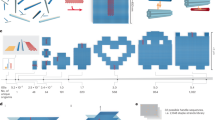Abstract
We introduce staged self-assembly of Wang tiles, where tiles can be added dynamically in sequence and where intermediate constructions can be stored for later mixing. This model and its various constraints and performance measures are motivated by a practical nanofabrication scenario through protein-based bioengineering. Staging allows us to break through the traditional lower bounds in tile self-assembly by encoding the shape in the staging algorithm instead of the tiles. All of our results are based on the practical assumption that only a constant number of glues, and thus only a constant number of tiles, can be engineered. Under this assumption, traditional tile self-assembly cannot even manufacture an n × n square; in contrast, we show how staged assembly in theory enables manufacture of arbitrary shapes in a variety of precise formulations of the model.















Similar content being viewed by others
Notes
Here we view the mixing time required in each stage (and the volume of each bin) as a constant, mainly because it is difficult to analyze precisely from a thermodynamic perspective, as pointed out in (Adleman 2000). In our constructions, we believe that a suitable design of the relative concentrations of tiles (a feature not captured by the model) leads to reasonable mixing times.
With a typical implementation in DNA, glues actually attach to unique complements rather than to themselves. However, this depiction of the glue function is standard in the literature and does not affect the power of the model.
References
Adleman LM (2000) Toward a mathematical theory of self-assembly. Technical Report 00-722, Department of Computer Science, University of Southern California
Adleman L, Cheng Q, Goel A, Huang M-D (2001) Running time and program size for self-assembled squares. In: Proceedings of the 33rd annual ACM symposium on Theory of Computing, pp 740–748
Adleman L, Cheng Q, Goel A, Huang M-D, Kempe D, de Espanés PM, Rothemund PWK (2002) Combinatorial optimization problems in self-assembly. In: Proceedings of the thirty-fourth annual ACM symposium on Theory of Computing, pp 23–32 (electronic), New York, ACM
Aggarwal G, Cheng Q, Goldwasser MH, Kao M-Y, de Espanes PM, Schweller RT (2005) Complexities for generalized models of self-assembly. SIAM J Comput 34(6):1493–1515
Barish RD, Rothemund PWK, Winfree E (2005) Two computational primitives for algorithmic self-assembly: Copying and counting. Nano Lett 5(12):2586–2592
Kao M-Y, Schweller R (2006) Reducing tile complexity for self-assembly through temperature programming. In: Proceedings of the 17th annual ACM-SIAM symposium on discrete algorithm, pp 571–580
Li M, Vitanyi P (1997) An introduction to komogorov complexity and its applications, 2nd edn. Springer Verlag, New York
Mao C, LaBean TH, Reif JH, Seeman NC (2000) Logical computation using algorithmic self-assembly of DNA triple-crossover molecules. Nature 407:493–496
Park SH, Pistol C, Ahn SJ, Reif JH, Lebeck AR, Dwyer C, LaBean TH (2006) Finite-size, fully addressable DNA tile lattices formed by hierarchical assembly procedures. Angewandte Chemie 45:735–739
Reif J (1999) Local parallel biomolecular computation. In: Proceedings of DNA-based computers, pp 217–254
Rothemund PWK (2006) Folding DNA to create nanoscale shapes and patterns. Nature 440:297–302
Rothemund PWK, Winfree E (2000) The program-size complexity of self-assembled squares. In: Proceedings of the 32nd annual ACM symposium on Theory of Computing, pp 459–468
Rothemund PWK, Papadakis N, Winfree E (2004) Algorithmic self-assembly of DNA sierpinski triangles. PLoS Biol 2(12):e424
Seeman NC (1998) DNA nanotechnology. In: Siegel RW, Hu E, Roco MC (eds) WTEC workshop report on R&D status and trends in nanoparticles, nanostructured materials, and nanodevices in the United States
Shih WM, Quispe JD, Joyce GF (2004) A 1.7-kilobase single-stranded DNA that folds into a nanoscale octahedron. Nature 427:618–621
Soloveichik D, Winfree E (2004) Complexity of self-assembled shapes. In: Revised selected papers from the 10th international workshop on DNA computing. Lecture notes in computer science, vol 3384. Milan, Italy, pp 344–354
Somei K, Kaneda S, Fujii T, Murata S (2006) A microfluidic device for DNA tile self-assembly. In: DNA computing. Springer, Berlin/Heidelberg, pp 325–335
Wang H (1961) Proving theorems by pattern recognition—II. Bell System Tech J 40(1):1–41
Winfree E (1998) Algorithmic self-assembly of DNA. PhD thesis, California Institute of Technology, Pasadena
Winfree E, Liu F, Wenzler LA, Seeman NC (1998) Design and self-assembly of two-dimensional DNA crystals. Nature 394:539–544
Acknowledgments
We thank M. S. AtKisson and Edward Goldberg for extensive discussions about the bioengineering application. E. D. Demaine and M. L. Demaine research was partially supported by NSF CAREER award CCF-0347776 and DOE grant DE-FG02-04ER25647. M. Ishaque, D. L. Souvaine and E. Rafalin research was partially supported by NSF grant CCF-0431027. E. Rafalin’s work was performed at Tufts University.
Author information
Authors and Affiliations
Corresponding author
Rights and permissions
About this article
Cite this article
Demaine, E.D., Demaine, M.L., Fekete, S.P. et al. Staged self-assembly: nanomanufacture of arbitrary shapes with O(1) glues. Nat Comput 7, 347–370 (2008). https://doi.org/10.1007/s11047-008-9073-0
Received:
Accepted:
Published:
Issue Date:
DOI: https://doi.org/10.1007/s11047-008-9073-0




